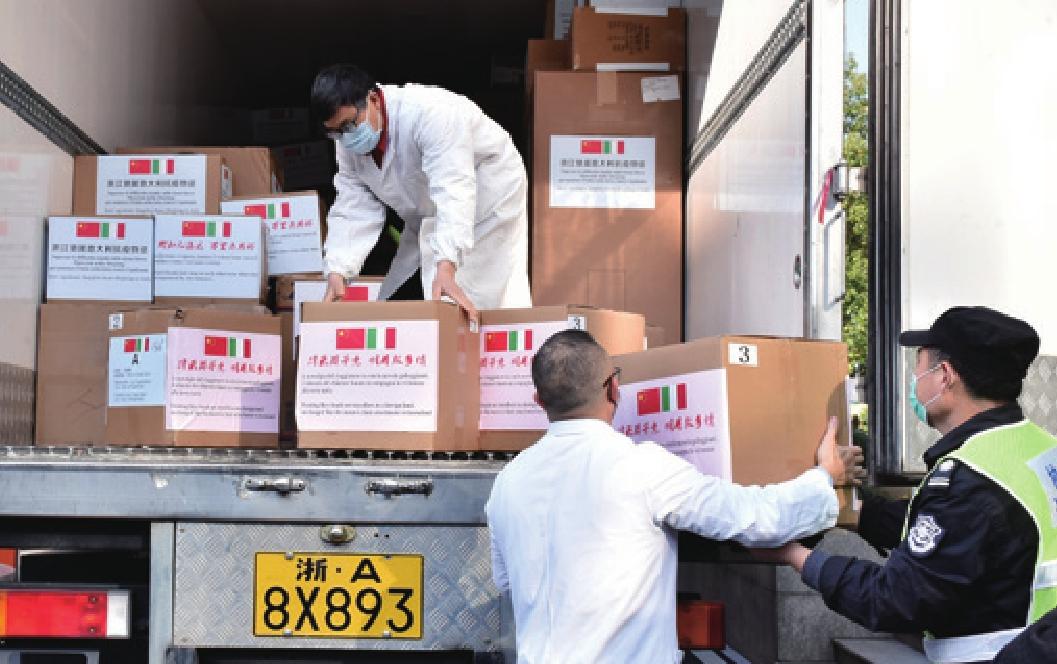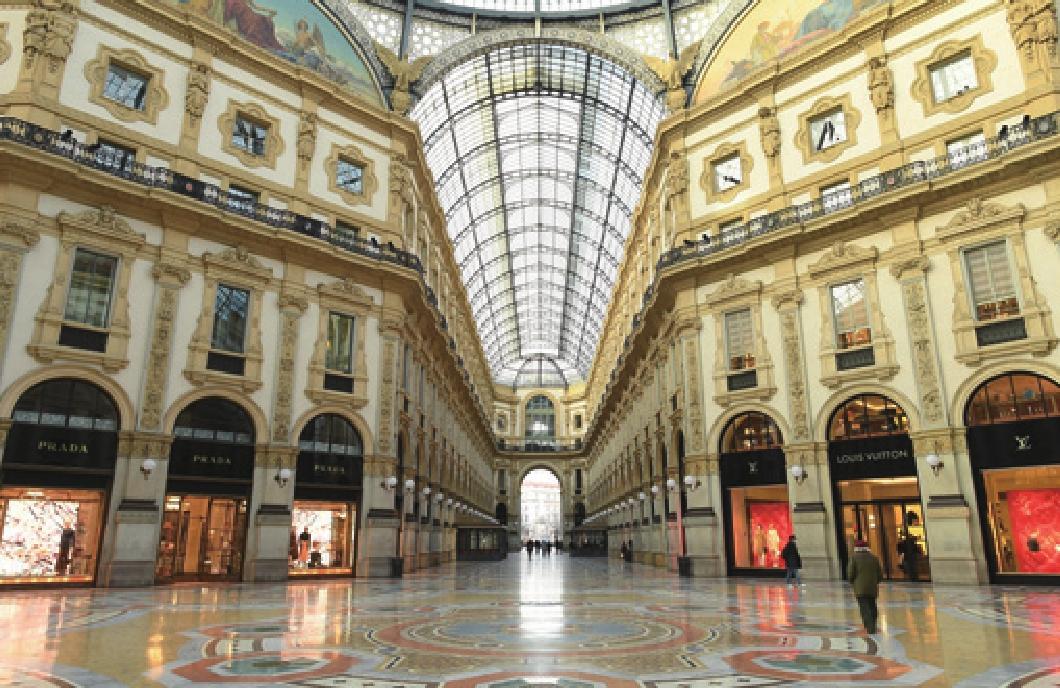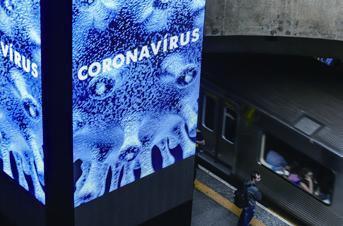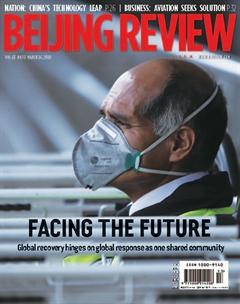SHARED ANSWERS FOR SHARED PROBLEMS
By Wen Qing



A video posted on the Internet on March 17 showed an unusually intense farewell. People crammed their balconies in a community in Wuhan, Hubei Province, waving and mouthing their gratitude through their masks: “Thank you for reaching out to us.”“Thank you for your hard work.”
The appreciation was for the medical workers who had come from Tianjin in north China to help out with the novel coronavirus disease 2019 (COVID-19) treatment and prevention and were leaving as the infection had been brought under control.
On their way to the bus that would take them to the airport, the overwhelmed visitors waved back and said their farewell.“Please stay strong,” urged one of them. “I will come back to see this city when the disease is eradicated,” said another.
It was the first medical team from outside Hubei to leave. After the outbreak, over 42,000 medical workers from across the country came to Hubei and their concerted efforts and dedication saw the number of new cases go down. On March 19, no new case was reported in Wuhan, a contrast to the peak period in February, when the number reached more than 1,000 on a single day.
It signaled the rescue medical teams could finally leave one by one and the first batch departed on March 17.
But though the situation is under control in China, the disease has become a pandemic, erupting in 159 countries and regions, from Europe to the Middle East to Africa. By March 18, 35 countries had declared a state of emergency, heightening the need for the international community to work together to defeat the disease.
A shared community
“The outbreak is a test of our solidarity—political, financial and scientific,”World Health Organization (WHO) Director General Tedros Adhanom Ghebreyesus said. “We need to come together to fight a common enemy that does not respect borders, ensure that we have the resources necessary to bring this outbreak to an end, and bring our best science to the forefront to find shared answers to shared problems.”
Chinese State Councilor and Foreign Minister Wang Yi said on March 18 that China will provide assistance within its capacity to countries in need to fight COVID-19, upholding the concept of one human community with a shared future.
Europe has become the new epicenter of the disease with Italy reporting the second highest number of confirmed cases and deaths after China by March 18. The difference, however, is that the fatality rate in Italy is nearly 8 percent, much higher than the 2.3 percent in China. This is partly attributed to Italys severely aging society, with the average age of those who died being 81, while over two thirds had other medical conditions.
“Italy asked to activate the European Union (EU) mechanism of civil protection for the supply of medical equipment for individual protection but unfortunately, not a single EU country responded,” Maurizio Massari, Italys Permanent Representative to the EU, wrote in an article. “Only China responded bilaterally.”
China sent experienced medical workers to Italy along with medical supplies. Some of the medical personnel had worked in Wuhan and have a wealth of experience and understanding of the virus.
About the medical assistance and experts, Italian Foreign Minister Luigi Di Maio said China sent masks and ventilators.“Thats what we call solidarity,” he said.
Although WHO warned about COVID-19 when the outbreak grew in China and China put all its national resources at work to contain the virus, many European coun-s tries did not take the threat seriously.

Discussing how COVID-19 could ravage Italy, Michele Geraci, former Under Secretary of State at the Ministry of Economic Development, said the government did not pay enough attention to the virus in the early days. Although schools and businesses were shut down, people still moved freely in towns.
Maria Rita Gismondo, a leading researcher, went public saying COVID-19 was not to be feared since the seasonal flu had killed more people in Italy in 2020. All these confusing signals made people lower their guard.
Italy and even the EU had not been strict enough and were slow to act, Geraci told Guangzhou Daily.
Spain and France also have been among the worst-hit in Europe. Many people disregarded the warnings about avoiding mass gatherings.
For example, on March 3, thousands of French people took to the streets to protest the pension reform plan. On March 8, thousands of women in Spain and France marched in International Womens Day rallies.
A week later, Spain announced a twoweek state of emergency, a lockdown similar to Italys, after reporting 1,500 new coronavirus cases in a day. Shortly after Prime Minister Pedro Sánchezs decree to that effect, his wife Bego?a Gómez tested positive for COVID-19.
In the Middle East, where Iran is the most severely affected, long conflicts and political turmoil have generally weakened the medical systems. Besides, according to Iranian Parliament Speaker Ali Larijani, U.S. sanctions, which target medical and laboratory supplies to Iran, are hampering Irans efforts to control COVID-19.
The Chinese Government has sent medical supplies to Pakistan, Laos, Thailand, Iran, the Republic of Korea, Japan and the African Union, Foreign Ministry spokesperson Geng Shuang said at a press briefing on March 18. Besides, it has donated $20 million to the WHO for assisting other countries. Local governments in China have also donated masks, protective clothing, test kits and other medical supplies to their sister cities in foreign countries.
In addition, China has shared its medical knowhow. Its healthcare professionals have gone to Iran, Iraq, Italy and other countries, lending their expertise. The sharing has been widened through video conferences with more countries and international organizations.
For instance, on March 18, Chinese experts took part in an online video conference attended by nearly 300 African officials and specialists. The experts detailed the trend of the pandemic, its features and the Chinese practices for disease control and treatment.
The Chinese corporate sector has also responded. The Jack Ma Foundation, the charitable organization of Ma, founder of the e-commerce giant Alibaba Group, sent 500,000 test kits and 1 million masks to the U.S. It also donated medical supplies to Japan, the Republic of Korea, Italy, Iran, Spain and African countries.
Besides, the foundation has compiled a handbook from doctors experience in treating COVID-19 patients. “As most regions in the world will face challenges, I hope this practical experience could be shared among all medical workers to make them prepared,” Ma wrote on his Chinese social media account.
The Sany Group, a construction and mining equipment manufacturer based in Changsha, Hunan Province, with a worldwide presence, sent 50,000 face masks to Germany on March 13. On each box there was a note quoting a German proverb,“Mountain and valley never come together, but people do.”
According to Sun Yongfu, a senior researcher with the Center for China and Globalization, a Chinese think tank, the measures taken by China to combat COVID-19 cannot be replicated in other countries as their national conditions are different. “But prevention and treatment experience could be shared,” he said. Also, “countries should enhance cooperation in joint scientific research on vaccines, test kits and treatment plans.”


